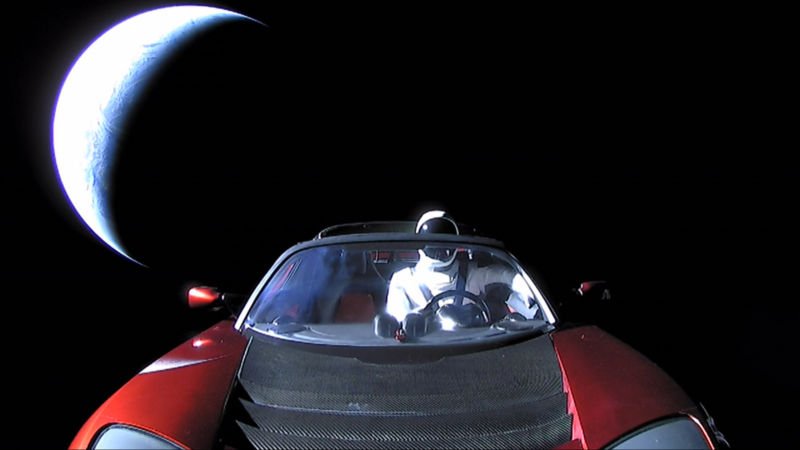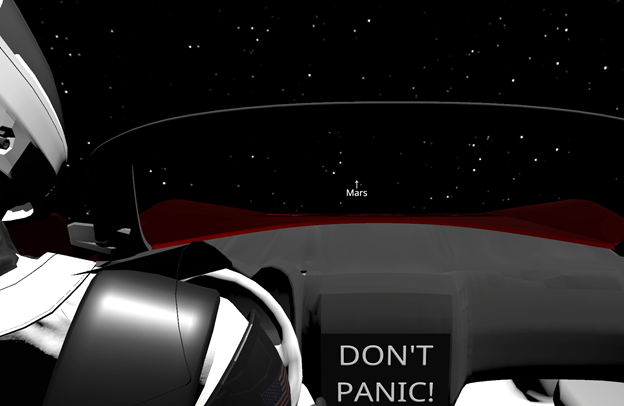Will Starman Camera Ever Broadcast Again
1-fashion journey —
Starman is out there, but we probably won't see him again until 2047
All future predictions had to be based on but vii weeks of loftier-quality data.

Enlarge / A launch-day photo of Starman leaving Earth's orbit.
SpaceX
A little more than a yr ago, SpaceX launched Elon Musk's personal Tesla Roadster, complete with a mannequin nicknamed Starman, wearing a SpaceX Dragon spacesuit. Almost six hours later, the Falcon Heavy rocket's upper stage fired for a final time, sending Starman into an orbit around the Sun, with an aphelion simply beyond the orbit of Mars. Since and so I, and others, accept wondered what the long-term fate of Starman will be.
At first, not much was known about the Tesla's location. The first inkling of its orbital parameters came from an prototype that Musk tweeted. (Later on, this turned out to be inaccurate). The outset verified and publicly available location information came from the Articulation Space Operations Middle (JSpOC), the US Air Force command tasked with tracking objects in space. Merely this only covered the time it was in Earth orbit, not Starman'southward position after the terminal upper-stage fire. Using those ii pieces of information, on February seven, I created a website that allowed a person to encounter how far away the Tesla was from Earth. But this data was quite limited at first.
The next bit of data came from JPL Horizons, a tool produced by JPL's Solar System Dynamics organisation that is tasked with tracking objects in the Solar Organisation. On February 8, information technology used data provided directly from SpaceX to allow one with proper knowledge to query the system and determine exactly where Starman was at any given time. This provided useful data for a few months, but beyond that time period, the information simply could not provide enough information.
Over the ensuing months, JPL received tracking information provided by optical telescopes that allowed it to refine the trajectory for Starman. Some people fifty-fifty used this early information to predict Starman's long-term futurity; yet, the data had a very short arc and was simply really reliable for a few years at best. The best-known effort predicted that Starman would pass close to Earth in 2091 and resulted in a newspaper entitled "The Random Walk of Cars and Their Standoff Probabilities with Planets." But that initial 2091 prediction was inaccurate because the tracking information relied on only a week's worth of observational data.
JPL Horizons produced its final solution at the cease of March 2019. This came afterward the last known telescope to observe Starman, a 1-meter instrument at Las Cumbres Observatory near Sutherland, South Africa, did so on March nineteen, 2019. Later that time, all futurity predictions had to be based on just 7 weeks of high-quality data.
These predictions are fabricated by taking the position in the heaven of the observations and using that to fit a model of the orbital path around the Dominicus. With seven weeks of information, nosotros can get a pretty good guess of that path, and the current predictions have a calculated dubiousness of just a few kilometers. There are some consequent errors that bear witness upward when computing such information, the most common beingness steady non-gravitational dispatch. This can exist caused past the small, steady pressure of sunlight, differences in the temperature of different sides of the vehicle, and out-gassing. (Outgassing is an effect of sunlight boiling some of the non-metal parts of the vehicle, which will cause a small pressure departure over time.)
The measurements that take been made of Starman show that information technology is existence pushed slightly away from the Dominicus. The data should be very authentic for about 50 years, just as it has shut passes with planets, particularly Earth, that doubtfulness will grow considerably. After 100 years it will be much less reliable.
What we can say for at present
The next time Starman will pass close to a planet will be to Mars on October 7, 2020. This will not be a particularly close pass; it will be virtually iv.6 million miles (vii.four million km) away from Mars. At that distance, Mars will appear but as a tiny dot, as seen in this simulation. This will not be plenty to significantly modify the orbit of the Tesla.

Simulated view of Starman on October seven, 2020.
Ben Pearson/ Where is Roadster 3D simulator
There are many instruments at Mars—could whatsoever of them see Starman in 2020? The biggest telescope about Mars is the HiRISE musical instrument, which has occasionally imaged vivid stars, and even Jupiter. However, information technology is not configured as an astronomical telescope and, due to its blueprint, can only see bright objects, and then it would not piece of work to image Starman, which is predicted to be a magnitude 22 object as seen from Mars in 2020.
A much closer pass will happen at Mars on April 22, 2035. The distance this time volition just exist about ane.4 million miles (2.3 million km), and has a small run a risk of being much closer. The predicted error is college the farther in fourth dimension i goes, merely at this point things are nonetheless accurate plenty to exist very confident it will be that shut to Mars within three hours of the prediction.
Information technology is theoretically possible that a telescope could be placed on Mars by 2035 that will be able to observe Starman. A one-meter telescope, such as the South African telescope that concluding observed Starman, could easily do it. With and then many new super-heavy rockets beingness planned, ane of them could mayhap carry such a payload to Mars by then.
(It is worth noting that, in gild to resolve more than a dot, Starman would have to brand a pass within 37,000 miles (60,000km) of a telescope 10m (33 anxiety) in diameter. This is the size of the largest telescopes on Earth, so unless Starship starts flying past Starman every bit office of a Solar System cruise, we may never resolve the Tesla or Starman again.)
How about the next Earth flyby? Shut approaches to Earth are predicted to happen about every 30 to 35 years, often in pairs. The first of these close passes will occur on January 11, 2047. The distance is predicted to be about 3 million miles (four.8 million km), which is shut plenty that it tin certainly exist seen from Earth, about four times closer than the last reported observation of Starman from South Africa. These new observations should allow us enough data to meliorate predict its journey throughout the Solar Organization for many hundreds of years to come. Starman will also make a 2d, slightly more than afar laissez passer in 2050.

Faux view of Starman on January 11, 2047.
Ben Pearson/ Where is Roadster 3D simulator
Afterwards this point in time, measurements get much less sure. A very small mistake becomes a much larger i over and then many years, and modest errors are magnified by a huge margin when passing shut to a trunk such as Earth. Furthermore, predictions are complicated by non-gravitational forces such as sunlight; we practise not know how Starman is oriented, which volition profoundly influence this force.
From 2050 to 2085, we know that Starman will be in the region between Earth and Mars, making a few distant flybys of Mars, only none particularly shut, likely no closer than information technology will exist in 2020. The next time it will be close to Globe is effectually Jan ane, 2085, merely the predictions are much less certain that far out—it could be off by as many every bit iv days in either direction. A second shut approach will happen around March nine, 2088.
Beyond this bespeak we just don't take much data, simply the electric current predictions are for close approaches in 2119 and 2123 to Earth. Beyond this point in time, it is extremely difficult to know if a close approach volition even happen at that time. During this entire catamenia of fourth dimension Starman is predicted to remain in roughly the same orbit, although there is a significant gamble its orbit might start to accomplish out farther, maybe even reach the Asteroid Belt as Elon Musk initially stated.
Beyond simply tracking cars roaming through deep space, this kind of analysis can be helpful in other ways. Tracking asteroids and comets is extremely important; if one were to striking the World it could cause tremendous amounts of damage. Using the same tools that were used to make these predictions, scientists and engineers can predict the path of near-Earth objects that might someday hit our planet. These objects, like Starman, cannot be seen continually, and thus we must predict their paths with limited information—sometimes for many years into the future.
Source: https://arstechnica.com/science/2019/04/starman-is-out-there-but-we-probably-wont-see-him-again-until-2047/
0 Response to "Will Starman Camera Ever Broadcast Again"
Post a Comment